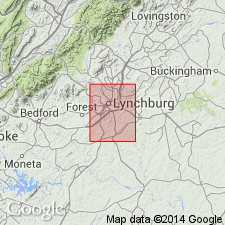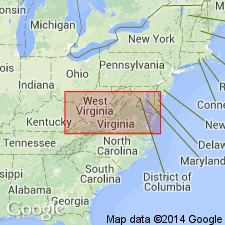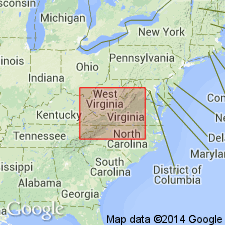
- Usage in publication:
-
- Virginia Blue Ridge complex
- Modifications:
-
- Named
- Dominant lithology:
-
- Schist
- Gneiss
- Granite
- Migmatite
- AAPG geologic province:
-
- Piedmont-Blue Ridge province
Summary:
Virginia Blue Ridge complex named. Its rocks form inner or core portion of Blue Ridge structural province in Virginia previously referred to as "injection complex", "granitized complex", and "basement complex." Includes schistose, gneissose, granitoid, and migmatitic rocks that are older than Lynchburg and Swift Run formations. Principal units include Pedlar formation, Marshall gneiss, Lovingston gneiss and granite, Roseland anorthosite, and Moneta gneiss (with Reusens migmatite facies). Age is Precambrian.
Source: GNU records (USGS DDS-6; Reston GNULEX).

- Usage in publication:
-
- Virginia Blue Ridge complex
- Modifications:
-
- Revised
- AAPG geologic province:
-
- Piedmont-Blue Ridge province
Summary:
Virginia Blue Ridge complex includes Lovingston, Marshall, Pedlar, and Robertson River formations, Roseland anorthosite, Striped Rock granite, Moneta gneiss, Saddle gneiss, Cattron diorite, Beaverdam Creek augen gneiss, Comers granite gneiss, Grayson granodiorite gneiss, Shoal gneiss, and Carsonville granite.
Source: GNU records (USGS DDS-6; Reston GNULEX).

- Usage in publication:
-
- Blue Ridge complex†
- Modifications:
-
- Abandoned
- AAPG geologic province:
-
- Piedmont-Blue Ridge province
Summary:
[Virginia] Blue Ridge Complex abandoned. No explanation given.
Source: Modified from GNU records (USGS DDS-6; Reston GNULEX).
- Usage in publication:
-
- Virginia Blue ridge basement complex*
- Modifications:
-
- Overview
- AAPG geologic province:
-
- Piedmont-Blue Ridge province
GNC Staff, 2008, [U.S. Geologic Names Committee remarks on geologic names, 2008]: U.S. Geological Survey, unpublished Geologic Names Committee note
Summary:
For more information, please contact Nancy Stamm, Geologic Names Committee Secretary.
Asterisk (*) indicates published by U.S. Geological Survey authors.
"No current usage" (†) implies that a name has been abandoned or has fallen into disuse. Former usage and, if known, replacement name given in parentheses ( ).
Slash (/) indicates name conflicts with nomenclatural guidelines (CSN, 1933; ACSN, 1961, 1970; NACSN, 1983, 2005, 2021). May be explained within brackets ([ ]).

